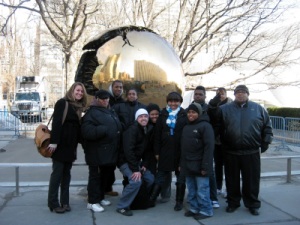Young people from New York contribute to the UNICEF report “The State of the World’s Children: Children in an Urban World”

The ATD Fourth World Youth Group in New York has contributed to the report “The State of the World’s Children: Children in an Urban World” that has been launched on the 28th of February 2012. In this collective article young people present the rougher side of this famous city. Violence, lack of resources and opportunities, overpopulation, constant changes are among the mayor challenges they face. They speak also about change: “By living through so many of the injustices associated with growing up in under-resourced neighbourhoods, we’ve gained the knowledge we need to start the process of change, change that will create places where all families are treated with respect and dignity”.
Speaking for Ourselves
By the ATD Fourth World Movement Youth Group, New York City
NEW YORK, USA, 22 February 2012 – People all over the world hear stories, watch movies and see postcards of New York City. They recognize our skyline – the Empire State Building, the Statue of Liberty or the Brooklyn Bridge – on sight. But New York City is not just about the big lights, the big buildings. There are the streets, and then there are the people who walk them, and when you live here you learn that New York is just like any city, filled with people who struggle to make ends meet.
In the neighbourhoods where we are growing up, we see the rougher side of this famous city. Poverty is part of life in our overcrowded and under-resourced communities. Peer pressure influences kids to drop out of school, and many end up in jail or dead. The face of poverty might change from one place to the next, but how poverty is felt is the same. It connects us with young people from other cities.
We live in different parts of the city, but we have had the common experience of sharing in street libraries. These are outdoor libraries, set up on blankets by volunteers who bring books and arts to our neighbourhoods. The libraries are places of peace where young people and children can work together and support each other. They are important because violence is a major part of our lives. We have had to run away from family barbecues when shoot-outs began, and we have teachers who have stopped even trying to break up fights in class because they’re so common.
Gangs are one of the worst problems facing our communities. Gangs affect the entire neighbourhood, causing outbursts of violence and retaliation in our parks and influencing every decision we make, down to when and where we buy groceries, so that we can have a better chance of avoiding confrontation. We’ve seen enough to know that once you’re in a gang, you’re done. There is a good chance that you’ll have to die to get back out.
Young people feel a common pressure to gain respect and a sense of belonging, but overcrowded living conditions and constant changes in our lives can make accomplishing that impossible. Gangs give a kind of power and protection, and this creates a lot of pressure to join. It’s true that you can get respect for doing something you’re good at, but if you live in an under-resourced neighbourhood the opportunities and support you need to get truly good at something don’t come so often. The fact that people believe joining a gang is their best option shows how deeply problems run here.
Violence is serious in poor communities; it creates a cycle that keeps people in poverty. But extreme poverty is a form of violence itself, because it forces children and families to use so much of their energy to defend their rights against such threats as eviction and gentrification, which cause rents to rise and force poorer families to move frequently.
As a result, many of us have had to move to completely different neighbourhoods and schools. These kinds of transitions are always scary and challenging, but in the city, they are common and can be downright dangerous for us. When you’re new to a neighbourhood or school, people want to test you. If you fail those tests, you’re a target. Kids who don’t fit in get teased, harassed and even attacked. As our 17-year-old peer Crystal told a United Nations panel in 2011, she was attacked by seven girls on her way to a bus stop because she was wearing brand-name clothes popular at the school from which she had just moved, but shunned at her new school.
We’ve all had these kinds of experiences, but we have learned how to handle them and move forward.
Young people like us have a role to play. Even in difficult neighbourhoods there are the positive influences of strong families and inspiring people, and we have the power to seek out those positive role models and to become them ourselves. All of us want to be those people, and we want a chance to change the communities we grew up in for the better. By living through so many of the injustices associated with growing up in under-resourced neighbourhoods, we’ve gained the knowledge we need to start the process of change, change that will create places where all families are treated with respect and dignity.
Speaking out about our lives is part of how we can create that change. People can’t speak for us who have never lived the lives we describe. But when we get to speak on behalf of our own experiences and ourselves, that’s freedom of speech, and that’s a positive step.
This essay was contributed by Crystal Dantzler (aged 17), Najayah Foote (13), Tatyana Foote (13), Jammie Hatcher (11), Brianna Jeanniton (15), Jadora Lindsey (18), Malcom Smith (14), Shakora Townsend (15) and the young people of All Together in Dignity (ATD) Fourth World Movement, New York City.


